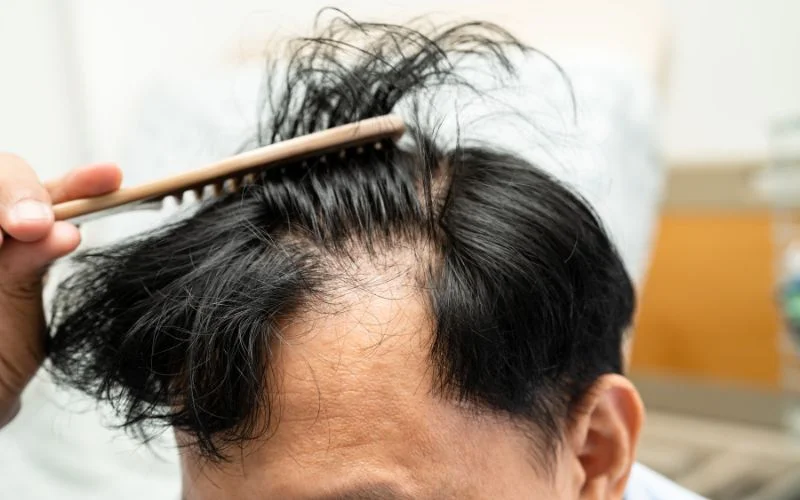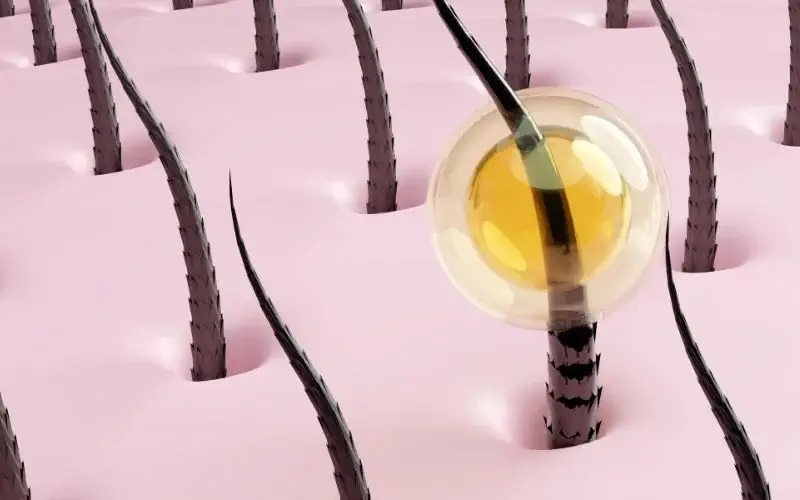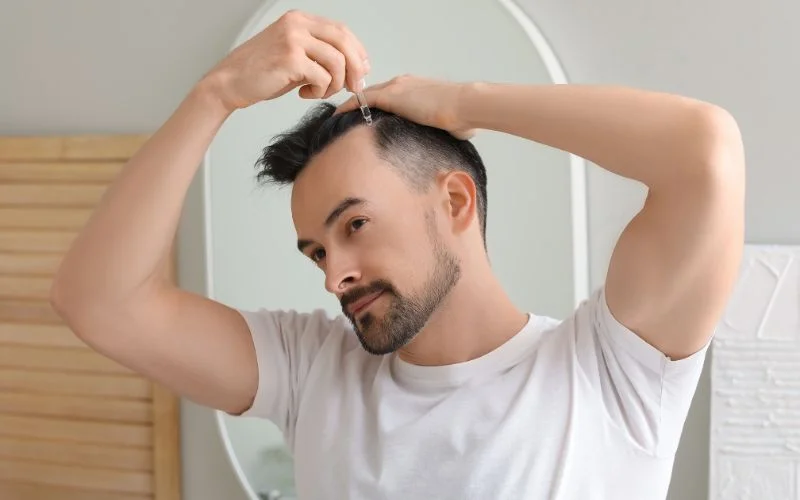Minoxidil is one of the most widely chosen hair growth products among both men and women. Those who have used minoxidil claim it to be an unbeatable hair loss treatment. But can this “holy grail” of boosting hair growth work on reversing the frontal baldness that most of men have to deal with?

Can Minoxidil Work Its Magic on Frontal Baldness?
Men and their possessiveness of hair is an age-old fact that almost every woman knows about.
From being their honor to their pride, hair means everything to a guy.
But what when the age factor kicks in and those luscious blacks all start to recede behind the hairline?
Yes, that’s heartbreak, but don’t worry we are here to protect both your heart and your hair.
But does minoxidil work on frontal baldness too?
Here is how you can find out if you can protect your precious hair from changing your look, or if it is too late to let minoxidil perform its magic.
What is Minoxidil?
Minoxidil was earlier a popular anti-hypertensive drug, whose effects on observation showed a significant boost in hair growth among users.
This effect was prominent among bald patients. Hence several studies were conducted to research Minoxidil’s effect on conditions resulting in baldness.
One such condition that saw a bright treatment with Minoxidil was androgenetic alopecia, or the genetic pattern baldness.
Based on these developments in the usage of Minoxidil, two formulations were derived:
- Minoxidil solution containing inactive ingredients coupled with water and propylene glycol.
- Propylene glycol-free Minoxidil foam
Out of these two formulations, Minoxidil foam shows better delivery of active ingredients and easy action of the formula with lesser irritation.
However, even the solution proved to be a good treatment option for AGA or androgenetic alopecia.
Based on the results of similar trials and studies, the FDA approved its usage topically for treating several hair disorders.
Minoxidil Usage in Hair Disorders
Although FDA approves topical Minoxidil for treating AGA, people also use it as a non-standard treatment for other hair disorders like:
#1. Alopecia Arrata – An autoimmune disease affecting the follicles of hair resulting in patchy appearance, alopecia, or complete loss of hair on the scalp and body. According to studies, Minoxidil helped these patients with a slight increase in hair growth.
#2. Chronic Telogen effluvium – Characterized by hair loss that goes on for 6 months or more. Studies show that oral minoxidil of as low as 0.25 to 2.5 mg dosage can reduce hair loss for women within 6 to 12 months.
#3. Chemotherapy-induced alopecia – According to controlled trials topical application of the minoxidil solution can help in reducing the hair loss caused by chemotherapy.
Some studies show a positive impact of using Minoxidil on enhancing body hair growth and beard.
However, despite all the positive results of Minoxidil that studies have listed, there isn’t a fully explained mechanism for its working.
Yet, we do have some science behind how minoxidil works on receding hairline including whether or not minoxidil works on frontal baldness and other disorders.
How does Minoxidil Work to Treat Hair Loss?

Minoxidil works by two mechanisms:
- Direct cellular proliferation of hair follicle cells
- Vasodilation
#1. Cellular Proliferation
Minoxidil has direct actions on the potassium channels present in the walls of arteries.
Doing so activates the cell membranes and helps in the proliferation or growth of a cell through different phases of the cell cycle.
In short, it can stimulate the growth of hair cells too.
However, this action of minoxidil on your hair follicles depends on the amount of sulfotransferase enzyme present in your hair follicles.
The enzyme reacts with the metabolites and minoxidil sulfate present in the composition of minoxidil formulation which people take for hair growth.
This reaction helps in the activation of the cell membrane and hence the growth of the hair follicle cells.
#2. Vasodilation
Another mechanism of Minoxidil that helps in increasing hair growth among users is its vasodilatory effect.
It dilates the blood vessels of your scalp and thus increases the blood flow toward your scalp, contributing to a better blood supply to the hair follicles.
This improves the delivery of oxygen and nutrients to the follicles, nourishing them for better growth and thickness.
While both mechanisms do answer the question about how minoxidil works for different hair disorders, can this also help frontal baldness?
Does Minoxidil Work on Frontal Baldness?
To answer this, let’s first begin to understand what frontal baldness is in the first place.
Frontal baldness, also known as a receding hairline or widow’s peak, is a type of hair loss that affects the front of the scalp.
It’s characterized by the hairline moving backward from the forehead, leaving the forehead more visible and prominent
However, it can also affect other regions of the scalp with the most common areas being the bi-temporal zone and the vertex.
Although it affects both men and women, the former group faces the condition in its worst condition.
In the early stages, men may notice a receding hairline at the temples, which can progress to form an “M” shape.
As the condition advances, the hairline may continue to recede until it forms a distinct “U” shape or a “V” shape at the front of the scalp.
Eventually, the hairline may recede to the crown of the head, resulting in complete baldness on the top of the scalp.
In addition to a receding hairline and widow’s peak, other features of frontal baldness in men can include:
- a thinning crown
- diffuse hair loss throughout the scalp
- the appearance of bald patches
It’s worth noting that frontal baldness can sometimes be a sign of an underlying medical condition, such as an autoimmune disease or a thyroid disorder.
Hence to seek what works for frontal baldness in the best way is by first understanding the causes of the condition.
Causes of Frontal Baldness
There can be various causes of Frontal baldness ranging from hair disorders to an underlying medical condition.
Hence it is best to first consult a dermatologist to see if the condition is associated with any underlying medical seriousness.
But if it’s because of the following hair disorders we do have a solution that’s going to make frontal baldness an easy history:
#1. Androgenetic Alopecia
It is a genetic condition and occurs in almost 80% of men by the time they reach 70 years of age.
The main features of the condition include thinning of hair that ultimately results in patches of small vellus hair.
Eventually, you even lose the small hair and significant balding occurs in the affected area.
Since the thinning of hair mostly starts from the temporal areas, it is a common cause of frontal baldness.
#2. Traction Alopecia
Traction or an excessive pull force on the hair like in tight braids can exert too much pressure on the hair follicles eventually causing a receding hairline in the frontal area.
Though it’s usually reversible you can change your hairstyle and let your hair relax to remove the pull pressure.
Yet, sometimes it can persist for too long and require attention.
#3. Frontal Fibrosing Alopecia
It’s a common cause of frontal baldness and is characterized by destroyed hair follicles which results in permanent loss of hair.
However, all these conditions can be well treated with Minoxidil and hence can help treat frontal baldness too.
But the question is how minoxidil works on frontal baldness when it is mostly used for genetic alopecia.
Effects of Minoxidil on Frontal Baldness
Minoxidil’s effects on frontal baldness are not studied vastly as compared to its effects on alopecia.
Also, if frontal baldness occurs because of frontal fibrosing alopecia where there is permanent damage to hair follicles, minoxidil might not be effective at all.
However, according to studies, if frontal baldness occurs because of androgenetic alopecia, there is a possibility of treatment with minoxidil.
Does Minoxidil Work on Temples or Frontal Baldness – Studies
Here are the research proofs that talk about does minoxidil works on frontal baldness.
Study I
Effects of 5% Topical Minoxidil Foam in Frontal and Vertex Scalp Among AGA Patients
Aim – The study aimed to see if there are any changes in the expression of genes in the areas of baldness post-treatment with Minoxidil.
Method –The study was conducted over a placebo-controlled study using the 5% topical solution of Minoxidil foam in 16 healthy men from the age groups 18 -49.
During the study, the groups were asked to either apply MF or a placebo twice a day for eight weeks.
Further, they were advised to clean their scalps only with the Progain shampoo and repeat the instructions for the substances.
To observe the effects of minoxidil and placebo on the groups, scalp photographs were taken, and then a final visit was done to note the results.
Further tests were conducted to finalize the before and after effects of both substances.
Results – In total 16 men were chosen for the study out of which 10 used the foam and 6 used placeboes.
Since 3 people didn’t complete the study, 13 samples of RNA from the frontal, vertex before and after the study were sent for examination to conclude the results.
According to the results, post-treatment with the minoxidil foam, there was a significant improvement in hair growth among users suffering from frontal and vertex baldness.
Study II
Effects of Oral Minoxidil in Treating AGA
Aim – The research aimed at studying the effects of 5 mg oral minoxidil in the treatment of Androgenetic alopecia.
Method – For the study, 30 men coming from the 24-59 years age group suffering from AGA affecting the vertex were selected.
All the participants were asked to take 5 mg oral minoxidil daily for 24 weeks.
Observations were made according to the hair count, diameter, before and after photographs, and questionnaires filled out by participants.
Results – According to the results, there was a significant increase in hair count in the 12th and 24th week from the baseline among the minoxidil group.
Though this was more significant in the vertex group, but there was also a great improvement in the frontal bald area.
After reading the studies, what do you now think of? Does minoxidil work on frontal baldness?
The answer is a yes, but what these studies also emphasize is the right usage of minoxidil if you want it to work.
How to use Minoxidil for Hair Growth?

There are three ways of using Minoxidil for effective hair treatment:
- Topical oils, solutions, and foam
- Dermarollers
- Capsules and supplements
#1. Topical Oils and Foam
Many companies sell topical solutions, foams, and oil-based formulations of minoxidil which can be an effective way of using it for hair growth.
However, there are some basic steps on how to apply minoxidil to the hairline, starting from selecting the right type of solution.
#1. Choose the Right Strength
Minoxidil comes in two strengths – 2% and 5%. The 2% solution is typically recommended for women, while the 5% solution is recommended for men. It’s important to choose the appropriate strength based on your gender and the severity of your hair loss.
#2. Apply to a Clean, Dry Scalp
Before applying minoxidil, make sure your scalp is clean and dry. You can use a mild shampoo to wash your hair if needed. Dry your hair thoroughly with a towel or blow dryer before applying the medication.
#3. Apply Directly to the Scalp
Minoxidil should be applied directly to the scalp, not to the hair. Use the dropper provided to apply the medication to the areas of your scalp that are affected by hair loss. Be careful not to apply too much, as this can lead to scalp irritation.
#4. Massage into the Scalp
After applying minoxidil, use your fingertips to gently massage the medication into your scalp. This will help to distribute the medication evenly and increase blood flow to the scalp.
#5. Leave in Place
After applying and massaging the medication into your scalp, leave it in place for at least 4 hours. You can apply minoxidil in the morning and evening, or as directed by your doctor.
#6. Wash your Hands
After applying minoxidil, be sure to wash your hands thoroughly to avoid accidental contact with your eyes or other parts of your body.
To boost the effectiveness of applying minoxidil on your hairline, you can try going for the derma roller available through various platforms.
#2. Derma-Rollers
Derma-rollers are devices that work on the principle of micro-needling that work by stimulating the blood flow to your scalp and hence amplifying the effects.
The design of the tool offers a handle that is connected to a barrel that has many small needles.
As you roll the barrel on your scalp, you need to apply a little pressure to let the barrel create small holes on the scalp.
These holes allow better penetration and absorption of minoxidil in your scalp while not causing any damage to the scalp.
Since micro-needling might seem complex to you, it is best to take it under a doctor’s guidance.
Once-a-week therapy is enough to increase the effectiveness of minoxidil on your hair.
However, in case none of the above two options work then you can go for the minoxidil capsules or the oral supplements.
#3. Oral Supplements – Capsules
Supplements are the last line of option for treating frontal baldness with minoxidil as the risk of side effects increase in cardiac patients as well as healthy people.
Hence always consult a doctor for the oral capsules of minoxidil and always follow the instructions described by your doctor.
Although all of these methods are active ways of incorporating minoxidil into your hair growth practice, the results are not quick and magical.
Rather, you must be patient with the results as minoxidil might take time to work.
Provillus hair loss treatment is one such product with minoxidil as the main ingredient. You can go through Provillus Hair Loss Treatment before and after results reviews to know whether the popular minoxidil supplement works.
What to Expect from Minoxidil Hair Treatment?
There are only 50-50 chances of a person responding to minoxidil treatment as the action depends on the levels of an enzyme sulfotransaminase present in your follicles.
The more enzymes, the better the action of minoxidil.
Also, the results depend on the severity of damage to the hair follicles, minoxidil works best for thinning hair or the early phase of baldness.
If you have permanently damaged follicles or severe balding, minoxidil might not be as effective as you think.
On the other hand, for some people, minoxidil can do wonders in just one year and show a great peak of results.
But by the time you reach 5 years with minoxidil massages, the results catch up a steady graph or become slow.
However, these results would still be better than people not using minoxidil for hair treatment.
On hearing such variations in results, many people might think of increasing the minoxidil dosage in their routines to amplify the results.
But that’s not how the compound works!
An ample amount of dosage in terms of the solution is not more than 5%. Where as in the case of oral supplements, it is generally decided by the doctor based on your condition.
Exceeding the limit only introduces you to the minoxidil side effects and not exceptional results.
Are there Any Minoxidil Side Effects?
It is best to consult a doctor before taking minoxidil as only a doctor suggests the right amount of minoxidil for your condition.
Since many drugs can interact with minoxidil too, taking a suggestion from a healthcare professional keeps you away from certain side effects like:
#1. Temporary Hair Fall
You might notice a temporary hair fall during the initial phases of minoxidil as when it starts working the old hair follicles are pushed out to let the new ones come in.
But excessive usage of the minoxidil can make this temporary hair fall more severe causing a serious hair loss problem.
#2. Allergy
Some people can be allergic to minoxidil or its carrier base like the propylene glycol mainly used in minoxidil solutions.
These allergies can be spotted with flakiness, itching, and redness in the scalp.
However, you can avoid the allergic reactions of PG by going for a Minoxidil foam that doesn’t contain any PG in its formula.
#3. Hypertrichosis
Heavy usage of minoxidil, can seep into your system causing several changes in your body like the excessive growth of hair in other areas of the body.
For example, people taking 5% of minoxidil solution might face such conditions.
The Last Hair Fall
Minoxidil treats many hair disorders, but does minoxidil work on frontal baldness?
The answer is a big yes!
Many studies prove that minoxidil is an effective formulation for treating frontal and vertex receding hairline.
But that means you should be aware of how to use it and how to maintain the right dosage.
Since minoxidil can sometimes be risky for your health, it is best to consult a doctor before using any capsules or topical solution for the same.
However, the right usage gives you a completely safe result.
If you’re looking for a hair loss treatment product with minoxidil, Provillus Hair Loss Treatment and give it a try!